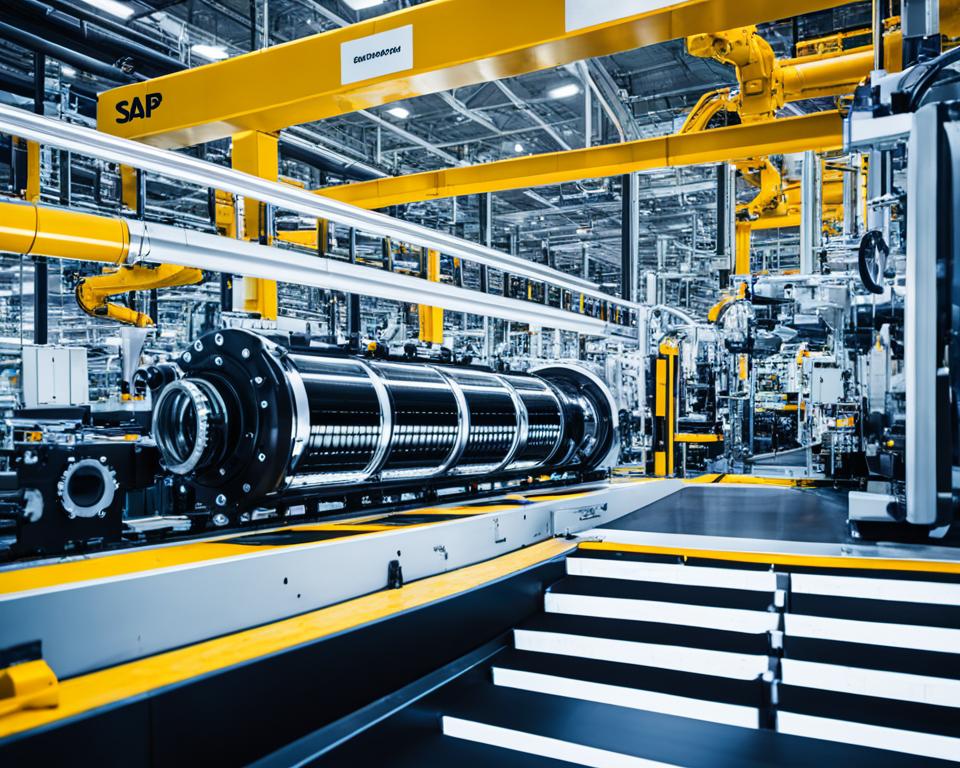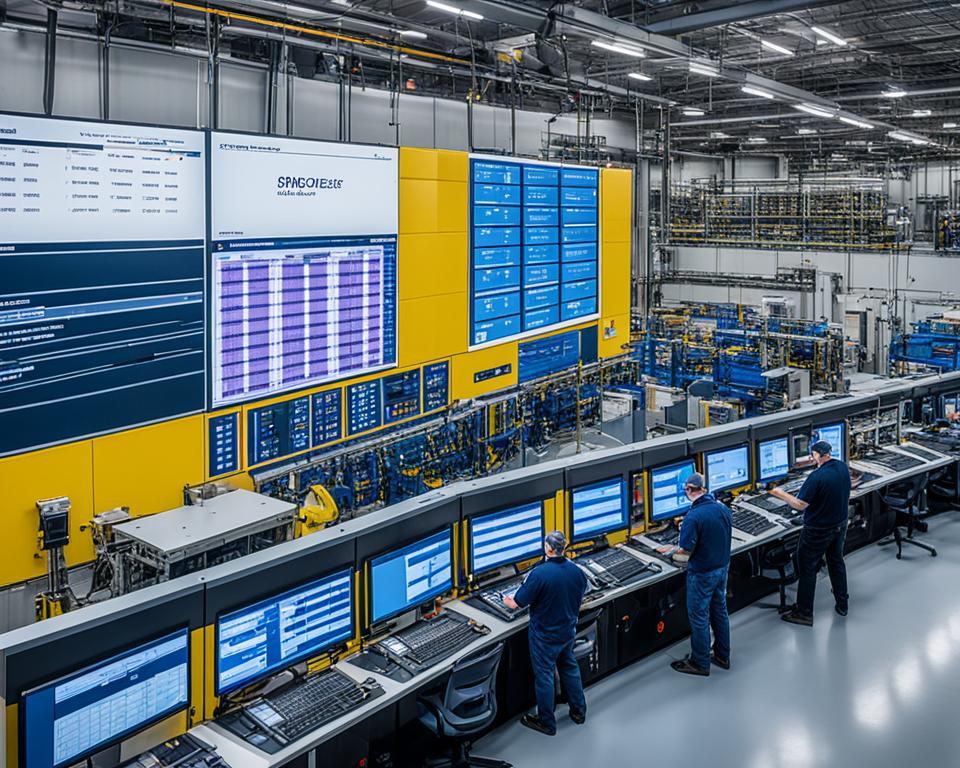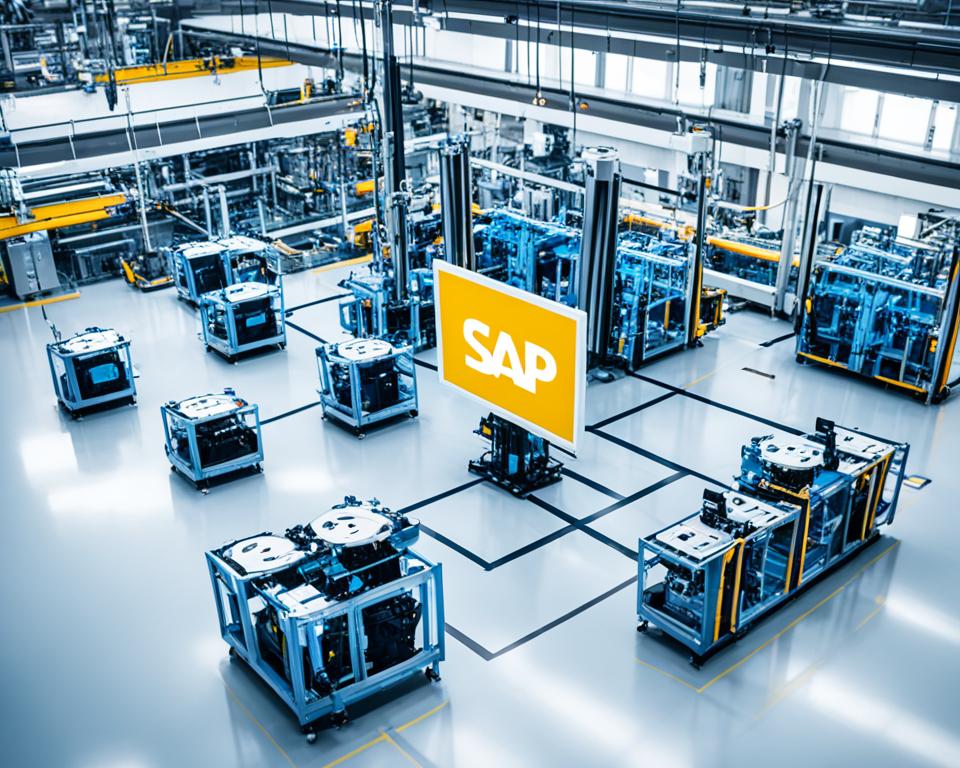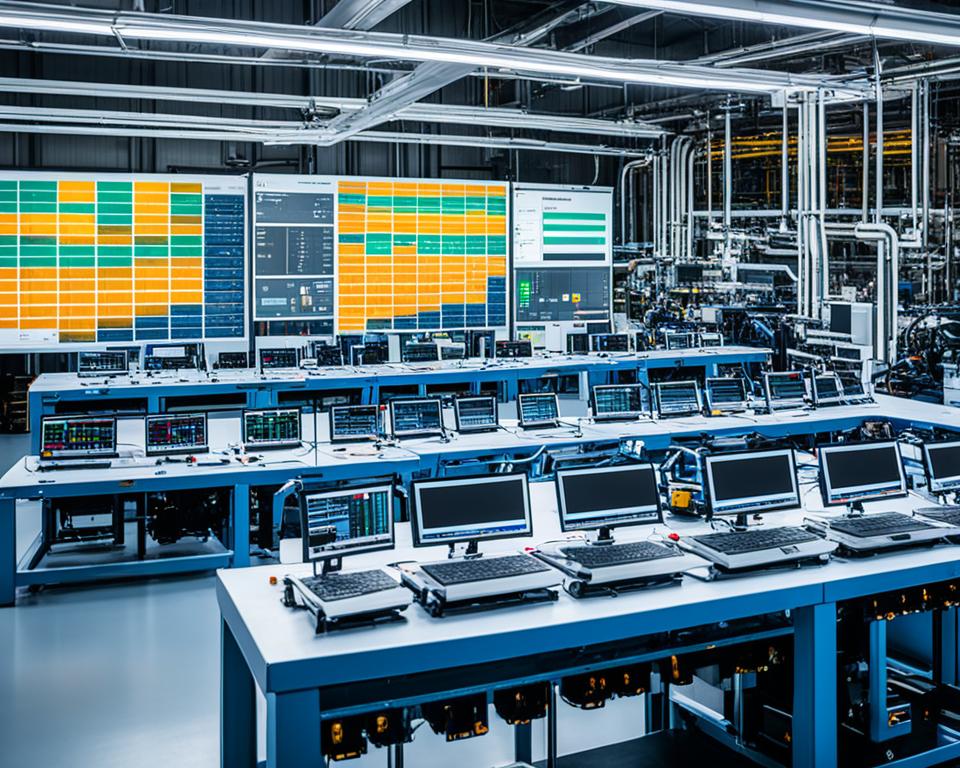Ever thought about how manufacturers can get super efficient and use data well? The secret is SAP MII, a top-notch solution that boosts manufacturing intelligence. It makes processes smoother and connects plants better. I’ll show you how this tool changes the game for making decisions and improving efficiency in manufacturing.
With SAP MII, companies can make their plants run better and boost productivity. This keeps them leading in a tough market. This tech is key for making smart choices and doing well in all areas.
Key Takeaways
- SAP MII improves operational efficiency through advanced manufacturing intelligence.
- Seamless plant integration is a core feature of SAP MII.
- Timely data facilitates better decision-making and responsiveness.
- Manufacturers can boost productivity and gain a competitive edge using SAP MII.
- Understanding SAP MII’s core objectives is crucial for its effective application.
Introduction to SAP MII
The introduction to SAP MII shows a powerful tool that boosts manufacturing efficiency. It links information technology with operational processes. SAP MII connects different systems and data sources, making businesses more agile and responsive.
SAP MII focuses on manufacturing integration. It brings together shop floor and enterprise systems. This creates real-time visibility into production, giving leaders the data they need for smart decisions.
SAP MII has strong features that help manufacturers improve processes, cut downtime, and boost productivity. It changes how operations work and aligns them with company goals. This makes it key for staying competitive in a fast-changing market.
| Key Benefits of SAP MII | Description |
|---|---|
| Real-Time Monitoring | Provides immediate insights into production activities and issues. |
| Improved Data Accuracy | Ensures reliable data through comprehensive system integration. |
| Enhanced Operational Agility | Allows for swift response to market changes and production demands. |
| Cost Reduction | Optimizes resource utilization and minimizes operational waste. |
Understanding Manufacturing Integration and Intelligence
Exploring manufacturing integration shows it’s key for success today. It means making sure processes, systems, and data work together across different parts of manufacturing. This makes intelligence in manufacturing better, helping with smarter decisions and smoother operations.
The SAP MII overview shows how modern tech helps with this integration. By using real-time data, companies can work more efficiently and save money. This focus on data helps make decisions based on facts, which is vital for success.
Having a strong plan for manufacturing integration is very important. It lets intelligence in manufacturing grow, helping companies quickly adapt to new market trends and customer needs. With tools like SAP MII, companies can see all parts of their manufacturing clearly. This helps teams work better together.

| Aspect | Impact on Manufacturing | Integration Solutions |
|---|---|---|
| Process Alignment | Improved operational efficiency, reduced waste | SAP MII, ERP systems |
| Real-time Data Utilization | Enhanced decision-making capability | IoT technologies, data analytics |
| Cross-Department Collaboration | Streamlined communication, accelerated product development | Collaboration platforms, integrated systems |
Understanding manufacturing integration and SAP MII shows a clear way to improve operations and make manufacturing smarter.
The Role of Plant Integration in SAP MII
Plant integration is key in SAP MII, making manufacturing better by linking data smoothly. It ensures info flows well between systems. This helps companies work better and more efficiently. With SAP MII, companies gain many benefits from being well connected.
Benefits of Seamless Plant Integration
Seamless plant integration brings many advantages. Here are some main SAP MII benefits for companies:
- Improved Data Flow: Real-time data access lets decision-makers act fast on new info.
- Enhanced Operational Efficiencies: Integration cuts downtime by linking machines to systems, making workflows smoother.
- Increased Agility: An integrated plant makes it easier to change production plans quickly based on demand.
Key Components of Plant Integration
For plant integration in SAP MII to work well, several key parts are needed:
| Component | Description |
|---|---|
| SCADA Systems | These systems watch and control industrial processes in real-time. |
| ERP Interfaces | These interfaces help talk between manufacturing and business operations. |
| Data Aggregators | They gather data from different sources for analysis and reporting. |
Production Monitoring with SAP MII
For manufacturers, keeping an eye on production is key to doing better. SAP MII makes it easy to see what’s happening right now. This lets me check important stuff like production speed and efficiency. By using this info every day, I can spot problems fast and fix them, making things run smoother.
Real-Time Data for Enhanced Monitoring
Having real-time data is vital for watching production closely. SAP MII gives me a clear view of how things are going, like how much is made, when machines stop, and how long things take. This info helps me make smart choices on the spot, cutting down on delays and hitting targets. Making changes quickly based on what’s happening now is key to doing great.
Tracking Production Performance and Efficiency
With SAP MII, I can keep an eye on how well we’re doing and make things better. It shows me all sorts of important numbers, which I check often. This helps us keep getting better and better, making us more efficient over time.
| Metric | Importance | Impact on Efficiency |
|---|---|---|
| Yield Rate | Measures product output vs. input | Higher yield improves overall productivity |
| Downtime | Tracks unproductive time due to machine failure | Reducing downtime leads to cost savings |
| Cycle Time | Duration to produce a finished product | Shorter cycle times enhance throughput |
Using SAP MII for production monitoring helps manufacturers use real-time data and analytics well. It’s not just about watching things; it’s about using that info to make big changes and find new ways to do things better. This makes companies more competitive and efficient. For more on how to make buying and managing inventory better, check out how Ariba works with SAP ERP here.

Achieving Operational Intelligence
In today’s manufacturing world, getting to operational intelligence is key. It means turning data into useful insights to make things run better. Unlike old ways that look back, operational intelligence uses current data to help businesses quickly adjust to new situations.
Defining Operational Intelligence in Manufacturing
Operational intelligence in manufacturing means seeing everything that happens in the process. It uses SAP MII to bring together lots of data. This way, companies can spot trends, predict problems, and make their work flow better. It helps use resources well and boosts productivity.
Leveraging Data for Decision Making
For today’s factories, making decisions with data is crucial. SAP MII helps by looking at how things are doing and what’s happening. This lets managers make smart choices based on the latest info. Moving to operational intelligence means managing resources better and improving how you work with suppliers. For those looking to make their buying process better, checking out ways to streamline Procure-to-Pay could be helpful.
| Aspect | Traditional Methodology | Operational Intelligence |
|---|---|---|
| Data Utilization | Historical Data | Real-Time Data |
| Decision Making | Reactive | Proactive |
| Efficiency | Lower | Higher |
| Visibility | Limited | Comprehensive |
Using tools like SAP MII for operational intelligence is key to success in manufacturing. It boosts efficiency and creates a place for ongoing improvement.
SAP MII and Manufacturing Execution Systems
Combining SAP MII with manufacturing execution systems makes operations better. I’ve seen how this partnership improves data visibility. It lets companies watch production as it happens.
This connection between SAP MII and MES makes things run smoother. It helps in making quick decisions and meeting production needs. With SAP MII, companies can use data to make processes better, cut downtime, and increase output.
Industry experts say companies gain a lot from this partnership. They get more efficient and accurate in tracking data and reports. This leads to better productivity overall. It makes operations smoother and more in line with business goals.

Enhancing Supply Chain Visibility
Visibility in the supply chain is key to making manufacturing processes more efficient and effective. I’ve seen how different factors can greatly affect this efficiency. By understanding these factors, manufacturers can make better decisions to improve things.
Factors Impacting Supply Chain Efficiency
Many things affect how efficient the supply chain is, including:
- Data Accuracy: Having accurate data is crucial for making good decisions.
- Communication: Good communication helps teams work together better.
- Technology Integration: Using systems that work together can make things run smoother and faster.
- Inventory Management: Keeping track of stock levels well helps avoid too much or too little inventory.
Using SAP MII for Supply Chain Insights
SAP MII gives great insights to improve supply chain visibility. It uses real-time data and analytics to spot trends and problems early. This lets manufacturers manage their supply chain better.
For example, with SAP MII, companies can keep an eye on production rates, what materials they have, and when things are shipped.
This platform is a key place for gathering and analyzing data. It helps manufacturers make quick, informed decisions. Using SAP MII insights helps businesses make their supply chains better, leading to better visibility and performance.
| Factor | Impact on Efficiency | Example |
|---|---|---|
| Data Accuracy | Improves decision-making | Real-time updates on stock levels |
| Communication | Enhances collaboration | Better alignment of supply and demand |
| Technology Integration | Streamlines operations | Automated order processing |
| Inventory Management | Optimizes stock levels | Minimizes excess inventory costs |
IoT Connectivity in SAP MII
IoT connectivity in SAP MII changes how we make things. It lets us collect data easily, giving us real-time insights. This helps us make better decisions fast. It makes manufacturing more flexible, letting us watch and adjust each step as needed.
Integrating IoT Devices for Data Collection
Adding IoT devices to SAP MII boosts data collection. Things like sensors and smart machines talk to each other and to the system. They send important data, helping us:
- Track equipment performance in real-time
- Keep things moving smoothly between steps
- Get alerts when something needs fixing
This setup keeps info flowing and lets us act fast if things go wrong.
Benefits of IoT in Manufacturing Operations
IoT brings big wins to making things. For example, it makes things faster and cuts waste. The main perks are:
- Improved efficiency: We can make changes quickly with real-time data.
- Enhanced quality control: We catch problems early.
- Cost reduction: Better processes and less downtime save money.
These changes are making manufacturing better, with IoT at the heart of new strategies.

| Benefit | Description |
|---|---|
| Increased Productivity | Higher output levels driven by optimized operational processes. |
| Reduced Waste | Minimized materials waste through efficient resource allocation. |
| Real-Time Data Access | Immediate availability of critical data for informed decision-making. |
Industrial Automation: A Focus Area for SAP MII
In today’s competitive world, industrial automation is key to boosting efficiency. SAP MII automation helps businesses make processes smoother, increase productivity, and improve quality. This makes them more efficient and competitive.
Automation tools in SAP MII let manufacturers keep an eye on operations as they happen. This means they can make quick decisions to stay ahead. I’ve seen firsthand how manufacturing automation cuts costs and speeds up production.
Real examples show how SAP MII helps with industrial automation. Companies in different fields use these tools to make their manufacturing better. For instance, using SAP Ariba solutions for procurement automation leads to better work with suppliers and clearer spending insights.
With better data management, companies can make choices based on facts. This leads to better procurement results. Industries that adopt these practices see big efficiency boosts. Industrial automation and SAP MII together form a strong base for modern manufacturing.
| Industry | Key Benefits of Automation | Case Study Example |
|---|---|---|
| Automotive | Improved production speed, quality assurance | Leading automotive manufacturer achieving 25% faster assembly line |
| Pharmaceutical | Enhanced compliance, reduced operational costs | Major pharmaceutical firm cut costs by 15% through automation |
| Consumer Goods | Better inventory management, increased adaptability | Consumer goods company increased inventory turnover by 30% |
By focusing on industrial automation, companies can set themselves up for growth and innovation. Using SAP MII for better system integration leads to major improvements in operations.
Data Analytics Powered by SAP MII
In today’s world, making it in manufacturing means using data analytics. SAP MII gives tools to analyze big data well. This helps companies make smart choices with real-time data, boosting efficiency and productivity.
Making Sense of Big Data in Manufacturing
Manufacturing creates a lot of data, which can be hard to handle. SAP MII helps turn this data into useful insights for better decisions. It starts with bringing together different data sources. Then, it makes the data easy to see, helping spot trends and patterns.
Proactive Analytics for Issue Identification
Proactive analytics lets me spot problems before they get worse. SAP MII is great at predicting issues like machine failures or bottlenecks. With these tools, companies can quickly fix problems, making workflows smoother and reducing downtime.

| Analytics Type | Functionality | Benefits |
|---|---|---|
| Descriptive Analytics | Summarizes past data | Identifies trends and patterns over time |
| Diagnostic Analytics | Investigates causes of past outcomes | Aids in understanding why issues occurred |
| Predictive Analytics | Forecasts future events based on historical data | Enables proactive measures to avoid issues |
| Prescriptive Analytics | Recommends actions based on data | Facilitates strategic decision-making |
Streamlining Communication Across Systems
Today, effective communication across systems is key in manufacturing. SAP MII brings big benefits by making different systems work together smoothly. It helps share data and keep operations running well.
SAP MII makes system interoperability better. It lets different apps and devices talk to each other easily. This means better decisions and less downtime. For example, linking Quality Management with production keeps quality high and spots problems fast.
SAP MII is great at bringing data from various systems into one place. This makes it easier to see everything and helps teams adjust quickly to changes.
To show how SAP MII helps, I made a table with key benefits:
| Benefit | Description |
|---|---|
| Enhanced Data Accuracy | Integration eliminates data silos, reducing errors from manual inputs. |
| Faster Response Times | Real-time communication allows teams to act swiftly to issues. |
| Improved Resource Allocation | Optimized communication leads to better use of equipment and manpower. |
| Reduced Operational Costs | Streamlined processes significantly lower costs related to inefficiencies. |
Using SAP MII makes manufacturing more coordinated and agile. Looking at the benefits, it’s clear that these technologies are crucial for success today.
Real-life Case Studies of SAP MII Implementation
Looking at real-life examples of SAP MII shows its big benefits for different manufacturers. Companies using this tech see big boosts in efficiency and productivity. This greatly helps their profits. I want to share some key stories that show why SAP MII is so valuable.
Success Stories from Leading Manufacturers
A famous car maker used SAP MII to make its production smoother. This move led to a 20% jump in how much they could make in a year. They could see real-time data, which helped them fix problems fast.
Another big electronics company used SAP MII to see its supply chain better. This led to a 15% cut in inventory costs.
Lessons Learned from SAP MII Adoption
From these case studies, we learned a few key things. First, getting everyone involved early makes it easier to start using SAP MII. Second, training your team well helps them use the system’s full power. It’s also key to keep an eye on the system to keep improving.
Integrating with Existing Manufacturing Systems
Integrating SAP MII with current manufacturing systems has its ups and downs. The main aim is to make things run smoothly and work better. It’s important to know how to connect these systems well.
Starting with SAP MII integration means checking out what you already have. You need to see if everything can work together well. Having a clear plan helps avoid problems and makes sure systems talk to each other right.
Using the best methods makes integration better. Important steps include:
- Working together from IT and operations teams.
- Having a plan to keep everyone updated.
- Using common ways to share data between systems.
When adding new systems, think about saving money too. Making procurement smarter with SAP MII can improve how you work with suppliers and spend less. This helps companies do better over time.
To wrap it up, making SAP MII work with your systems needs good planning and teamwork. Knowing the technical stuff and using the best methods helps make the change smooth and beneficial.
Best Practices for Implementing SAP MII
Implementing SAP MII well needs a clear plan. Start by getting your team ready for the changes ahead. This means more than just learning new tech. It’s about changing how your whole organization works.
It’s crucial to invest in training and development. This helps your team learn the skills they need.
Preparing Your Organization for Change
Getting your team ready for SAP MII is key. Start with a change management plan that includes:
- Stakeholder Engagement: Bring in important people early to get their input and support.
- Training Programs: Create training that fits different levels of users to boost skills.
- Communication: Keep employees informed about what’s happening and what changes to expect.
This helps make the move to SAP MII smoother and helps teams adjust to new ways of working.
Continuous Improvement Post-Implementation
After SAP MII is in place, the work doesn’t stop. Encourage a culture of ongoing improvement. This means:
- Regular Reviews: Check how the system is doing and look for ways to make it better.
- Feedback Loops: Ask users for their thoughts to find out what needs work.
- Adoption of New Features: Keep up with SAP MII’s new features to get the most out of it.
Using these steps sets the stage for ongoing success. It helps you get the most from SAP MII and keeps your organization flexible.
Future Trends in Manufacturing Intelligence
Looking ahead, we see big changes in manufacturing intelligence. New technologies are changing how we make things and run operations. It’s key for companies to get ready for these changes in SAP MII.
Emerging Technologies Impacting SAP MII
New tech is changing manufacturing, especially with SAP MII. Things like artificial intelligence (AI), machine learning, and advanced automation are making data analysis better and operations smoother. For example:
- AI and Machine Learning: These help predict problems and plan maintenance better.
- Blockchain: It makes supply chains more secure and transparent for SAP MII users.
- Digital Twins: These are virtual copies of real assets that help monitor performance and make quick changes based on data.
Preparing for Challenges Ahead
Even with the benefits of new trends, there are challenges in SAP MII. Companies need to get ready for these issues. Some of the main challenges are:
- Integration Issues: Making new tech work with old systems can be tough.
- Data Overload: Too much data can slow things down and make it hard to make decisions.
- Skill Gaps: With more automation, we need workers who know the new tech. Finding these people is key.
By planning with these new technologies and getting ready for challenges, manufacturers can stay ahead. Taking this step helps them keep up with the fast-changing manufacturing world.
Conclusion
SAP MII is key to changing how we make things by making processes work better together and smarter. It uses advanced data analysis and watches performance in real time. This helps make better decisions and gives a competitive edge in the market.
This article showed why it’s crucial for companies to use new solutions like SAP MII. It makes sharing information between systems easy and gives clear insights through data visualization. These benefits show how SAP MII can change production for the better.
Using technologies like SAP MII is a must in today’s fast-changing industry. Looking back at the main points, I urge companies to see the big potential of SAP MII. It can boost efficiency and innovate how things are made. For more details and resources, check out this helpful article on Ariba Reporting and Analytics.



Leave a Reply